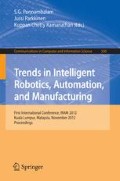Abstract
Neurorehabilitation aims to aid the recovery/rehabilitation of neurological patients following strokes, spinal cord injuries, traumatic brain injuries as well as other neurological diseases. The utilization of a rehabilitative robot can offer a repetitive and intensive rehabilitation training which helps improve the recovery rate and introduce a channel for patients to train independently or with minimal supervision. The future system will leverage on the utilization of EMG signal to drive the control system controlling the rehabilitative robot. Hence, it is necessary to investigate the influence of each muscle to the upper extremity’s movement. This paper presents the comprehensive observation on how 8 different muscles contribute to the flexion extension and abduction adduction movement of the upper limb. These muscles are biceps, triceps, deltoid, latissimus dorsi, brachioradialis, brachialis, flexor carpi radialis and flexor carpi ulnaris. The impact of each muscle to the upper limb’s movement will help in determining the EMG-force/torque relationship.
Access this chapter
Tax calculation will be finalised at checkout
Purchases are for personal use only
Preview
Unable to display preview. Download preview PDF.
References
Hademenos, G.J., Massoud, T.F.: Biophysical Mechanism of Stroke. American Heart Association, 2067–2077 (1997)
Hademenos, G.J., Massoud, T.F.: The Physics of Cerebrovascular Diseases: Biophysical Mechanism of Development, Diagnosis and Therapy (1997)
Grad, Y., Sievert, H., Nishri, B., Stone, G.W., Katzen, B.T., Yodfat, O., Higashida, R., Harris, D., Wakhloo, A.K., Assaf, Y., Norbash, A., Bushi, D., Lieber, B.B.: A Novel Endovascular Device for Emboli Rerouting: Part I: Evaluation in a Swine Model. Journal of the American Heart Association 2860–2866 (2008)
Stein, G.D., Hoffman, S.W.: Concepts of CNS plasticity in the context of brain damage and repair. The Journal of Head Trauma Rehabilitation 18, 317–341 (2003)
Kexin, X., Jian, H., Qi, X., Yongji, W.: Design of a wearable rehabilitation robotic hand actuated by pneumatic artificial muscles. In: Asian Control Conference, ASCC 2009, pp. 740–744 (2009)
Sucar, L.E., Leder, R., Hernandez, J., Sanchez, I., Azcarate, G.: Clinical evaluation of a low-cost alternative for stroke rehabilitation. In: IEEE International Conference on Rehabilitation Robotics, ICORR 2009, pp. 863–866 (2009)
Turolla, A., Tonin, P., Zucconi, C., Agostini, M., Piccione, M., Piron, L.: Reinforcement Feedback in Virtual Environment vs. Conventional Physical Therapy for arm motor deficit after Stroke. In: Virtual Rehabilitation, pp. 49–52 (2007)
Piron, L., Tombolini, A., Turolla, C., Agostini, M., Dam, M., Santarello, G., Piccione, F., Tonin, P.: Reinforced Feedback in Virtual Environment Facilitates the Arm Motor Recovery in Patients after a Recent Stroke. In: Virtual Rehabilitation, pp. 121–123 (2007)
Rosati, G., Gallina, P., Masiero, S.: Design, Implementation and Clinical Tests of a Wire-Based Robot for Neurorehabilitation. IEEE Transaction on Neural Systems and Rehabilitation Engineering 15, 560–569 (2007)
Dapeng, Y., Jingdong, Z., Yikun, G., Li, J., Hong, L.: EMG pattern recognition and grasping force estimation: Improvement to the myocontrol of multi-DOF prosthetic hands. In: IEEE/RSJ International Conference on Intelligent Robots and Systems, IROS 2009, pp. 516–521 (2009)
Siegler, S., Hillstrom, H.J., Freedman, W., Moskowitz, G.: Effect of myoelectric signal processing on relationship between muscle force and processed EMG. Arm. J. Phys. Med., 130–149 (1985)
Merletti, R., Sabbahi, M.A., De Luca, C.J.: Median frequency of the myoelectric signal: Effects of muscle ischemia and cooling. Eur. J. Appl. Physiol. Occup. Pysiol., 258–265 (1984)
Petrofsky, J., Laymon, M.: The relationship between muscle temperature, MUPA conduction velocity and the amplitude and frequency components of the surface EMG during isometric contractions. Basic Appl. Myol., 61–74 (2005)
Broman, H., Bilotto, G., De Luca, C.J.: Myoelectric signal conduction velocity and spectral parameters influence of force and time. J. Appl. Physiol., 1428–1437 (1985)
Bilodeau, M., Arsenault, A.B., Gravel, D., Bourbonnais, D.: The influence of an increase in the level of force on the EMG power spectrum of elbow extensors. Eur. J. Appl. Physiol. Occup. Pysiol., 461–466 (1990)
Oyong, A.W., Parasuraman, S., Jauw, V.L.: Estimation of Muscle Forces and Joint Torque from EMG using SA Process. In: IEEE EMBS Conference on Biomedical Engineering and Sciences (IECBES 2010), Kuala Lumpur, Malaysia (2010)
Parasuraman, S., Arif, W.O., Veronica, L.J.: AI Technique to estimate muscle force and joint torque upper extremity. Key Engineering Material 467-469, 788–793 (2011)
Oyong, A.W., Parasuraman, S., Jauw, V.L.: Robot Assisted Stroke Rehabilitation: Estimation of Muscle Force/Joint Torque from EMG using GA. In: IEEE EMBS Conference on Biomedical Engineering & Sciences (IECBES 2010), Kuala Lumpur, Malaysia (2010)
Patton, K.T., Thibodeau, G.A.: Anthony’s Textbook of Anatomy & Physiology. In: Wilhelm, T. (ed.), 19th edn. (2010)
Jacob, R., Moshe, B., Moshe, B.F., Mircea, A.: A Myosignal based powered exoskeleton system. IEEE Transactions on System, Man and Cybernetics 31(3) (2001)
Rhoades, R.A., Bell, D.R.: Medical Physiology: Principal for Clinical Medical, 3rd edn. Lippincott Williams & Wilkins
Kenneth, S.S.: Anatomy&Physiology: The Unity of Form and Function, 4th edn.
Author information
Authors and Affiliations
Editor information
Editors and Affiliations
Rights and permissions
Copyright information
© 2012 Springer-Verlag Berlin Heidelberg
About this paper
Cite this paper
Jauw, V.L., Parasuraman, S. (2012). Investigation on Upper Limb’s Muscle Utilizing EMG Signal. In: Ponnambalam, S.G., Parkkinen, J., Ramanathan, K.C. (eds) Trends in Intelligent Robotics, Automation, and Manufacturing. IRAM 2012. Communications in Computer and Information Science, vol 330. Springer, Berlin, Heidelberg. https://doi.org/10.1007/978-3-642-35197-6_24
Download citation
DOI: https://doi.org/10.1007/978-3-642-35197-6_24
Publisher Name: Springer, Berlin, Heidelberg
Print ISBN: 978-3-642-35196-9
Online ISBN: 978-3-642-35197-6
eBook Packages: Computer ScienceComputer Science (R0)

